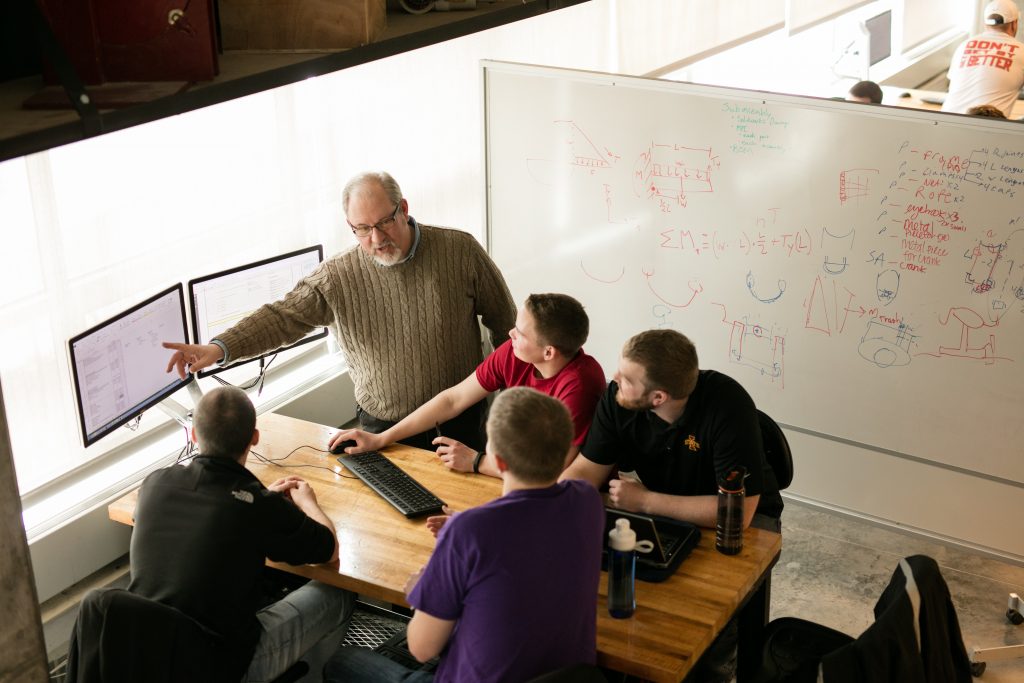
Iowa State University’s Department of Mechanical Engineering (ME) recently surpassed Georgia Tech University as the largest undergraduate ME program in the country.
According to data provided by each institution, ISU’s undergraduate ME program has 2185 students for the 2016-17 academic year, 28 students more than the Atlanta-based university.
“When I learned of the news, I felt some pride and satisfaction. Not in the sense of winning a competition, but that we were able to get to this point without a great deal of sudden disruption to our program,” said Cris Schwartz, director of the undergraduate program.
Schwartz, who also serves as an associate professor in the department, has led the undergraduate program since 2013. Over the past decade, overall enrollment at Iowa State has grown by 44 percent, while undergraduate enrollment in ME more than doubled between 2007 and 2015. Schwartz said that while the university as a whole experienced substantial growth during that time, a strong focus on curriculum and logistical planning helped the ME department manage its incredible growth.
“We were in a period of high growth but not yet facing the truly explosive enrollment growth in ME that occurred in the two academic years [after I took over the program in 2013],” he said. “Those times were challenging, but because of the wonderful curriculum and space planning teams in the department, we were able to grow our program capacity very quickly and in a way that has retained the fundamental nature of the ISU ME degree.”
Not only is ISU’s ME program the largest undergraduate program in the country but it’s also the largest undergraduate major on campus. Schwartz said he and his colleagues have developed planning tools and projections to help the department serve its many students in the most effective way possible.
“We have developed some fairly sophisticated models for predicting our program needs, and those tools give us some time to prepare the program for upcoming semesters. It is through these data-driven methods, along with truly excellent and motivated staff and faculty, that becoming the largest ME program in the country is just another step in our journey to achieve and maintain excellence as a program.”
Schwartz also attributed the increase in undergraduate enrollment to the high job placement rate in the mechanical engineering field as a whole nationally.
“Without a doubt, ME enrollment has grown nationally and that is largely dependent on the favorable job market for mechanical engineers. We see strong evidence of this immediately after the ISU Career Fair, when a number of engineering students request to transfer to ME because that is the most sought after major among the companies visiting,” said Schwartz.
Iowa State’s increased enrollment can also be attributed to the substantial increase it has seen in out-of-state students.
“In the case of our program, I think enrollment growth also has a lot to do with ISU’s regional reputation coupled with our fairly reasonable costs of attending in comparison to peer institutions in neighboring states,” said Schwartz. “In fact, the very largest segment of growth of our incoming freshmen class this year is students coming from Illinois.”
Schwartz also pointed out that over the past six academic years, one out of every ten new students on campus chose to study mechanical engineering out of a field of about 150 undergraduate majors.
Schwartz was an undergraduate at Iowa State himself in the 1990s and went on to also earn his MS and PhD degrees at ISU. He then spent about six years on the faculty at Texas A&M University before returning to Iowa State as an associate professor in 2012. He said he thinks the department has retained the hands-on emphasis which he remembers as a student.
“I think one of most amazing accomplishments of this program is that it still has the fundamental hands-on, get-the-job-done value system that it had back when I was a student here. The department was less than one-third the size that it is now, but we have been able to keep a number of the resource-intensive laboratories that we had back then. It amazes to no end that we still have a manufacturing laboratory as part of our curriculum,” Schwartz said.
“One of the most memorable things about my undergraduate time was the metal casting laboratory. I am delighted that we still have the resources and the ability to continue to teach that particular laboratory at a much larger scale than when I was a student.”
In addition to a well-rounded curriculum, top-notch facilities, and dedicated faculty, Schwartz said the strong support staff has also helped to make ISU’s mechanical engineering program one of the best in the country.
“One of the greatest improvements that I observe now, and am lucky enough to be involved with, is our excellent staff of full-time academic advisors,” Schwartz said. “When I was a student, I was advised by a faculty member about what courses to take. Now, students and parents are able to do quite a bit of long-term degree planning and emergency action by working with our advising staff.”
ME Department Chair Caroline Hayes said she sees Iowa State’s position as the nation’s largest undergraduate ME program as both an “honor” and a “responsibility.”
“It is an honor that so many students and their families have chosen us for their education,” said Hayes. “It is a responsibility because no other Mechanical Engineering department in the country has such a large impact on the mechanical engineering workforce. We have an ethical responsibility to provide our students with the very best education possible.”